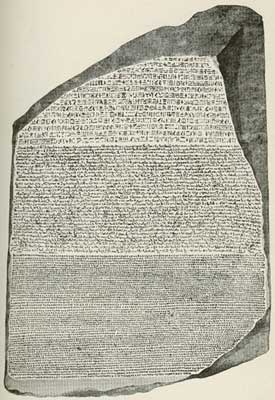The journey towards deciphering Egyptian hieroglyphs began in 1799 with the discovery of the Rosetta Stone by French soldiers in Napoleon’s invasion force. The stone was uncovered in the village of Rashid in Egypt, and proved to be a vital clue in the understanding of hieroglyphs. Into this relatively small granite slab is carved an inscription written in three different languages and scripts – hieroglyphs, demotic script, and ancient Greek. Each inscription repeats a decree passed by the general council of priests from throughout Egypt on the 1st anniversary of the accession of Ptolemy V Epiphanes, King of all Egypt, 27 March 196 BC.
Using the Greek inscription, and comparisons to other monuments, scholars such as the English physicist Thomas Young (1773-1829) and French scholar Jean-Francois Champollion (1790-1832) were able to identify names in the hieroglyphs. They then established that hieroglyphs were more than just pictures, but actually included both phonetic and non-phonetic symbols.
In a similar way to hieroglyphs, the deciphering of cuneiform script was made possible by the discovery of sites such as the ruins of Persepolis (identified in 1618) and the Behistun Inscription in the Zagros Mountains of western Iran. Like the Rosetta Stone, the Behistun Inscription is recorded in three scripts: Old Persian, Elamite and Babylonian.
Although much of cuneiform has been successfully deciphered, there are still elements that are not completely understood.
Likewise, there are other written languages still shrouded in mystery, such as the rongorongo script which is believed to have developed on Easter Island in Polynesia. No modern scholar has successfully deciphered it.

